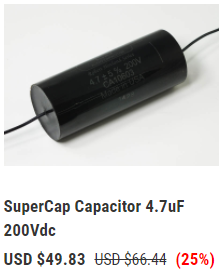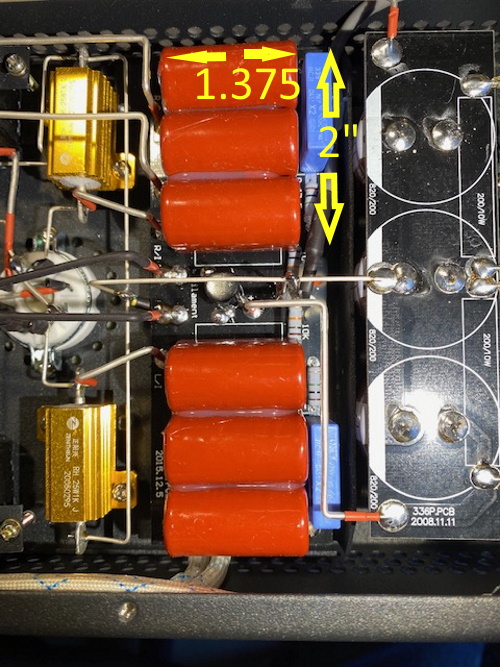bcowen
Headphoneus Supremus
ROFL! JJ started it....I'm just trying to be a good student and show that I'm paying attention.






I'm following along to see the final results of this experiment.ROFL! JJ started it....I'm just trying to be a good student and show that I'm paying attention.

Well, the 47k resistors didn't do much. Took "loud" from 7:00 to maybe 7:30. Tried a few other combinations, and finally with this combo (22k R1 and 4.7k R2) I'm getting the volume control up into the 11:00 to 12:00 position. I'm happy with that, although the input voltage reduction (from 2.0v down to 0.352v) seems a bit extreme which makes me even more suspicious of that pot. At least now I know this will work, but before I begin formal surgery I'm going to go ahead and swap the pot and see if the result is the same. And glory be...I just happen to have Rikens in those values. LOL!
One last question though: the drastic reduction doesn't pose any risk to the source component does it? Right now it's a Modi Multibit, but the Bifrost 2 that's in normal use has the same 2.0v output...
No risk to your components.
If it were me…
I'd opt for getting the pot in the 10-11 range as that means using a bit larger resistor values, which doesn't lower the input Ω of the amp quite as much.
But if you don't have those resistor values 'handy' then go with what is at hand.
As for changing the pot itself, yes now that you can compare the differences (albeit in only a minimal sorta way) that would be the next step.
It will be interesting to see what you notice after the new pot goes in.
JJ

If it were me…
I'd opt for getting the pot in the 10-11 range as that means using a bit larger resistor values, which doesn't lower the input Ω of the amp quite as much.
But if you don't have those resistor values 'handy' then go with what is at hand.
As for changing the pot itself, yes now that you can compare the differences (albeit in only a minimal sorta way) that would be the next step.
It will be interesting to see what you notice after the new pot goes in.
JJ
So I added Hovland SuperCaps as bypass caps for the main B+ power supply feed and for the bias caps that feed the 71A bias current.
They are settling in now.
And with the several recent changes, the SQ has been increasing, but I'm just now approaching the 20+ hr run time mark, where the SQ tends to reach a peak and the high water mark moves up a notch or 2 or 497845…
But these changes lately are remarkable in that the SQ across the board has taken a substantial Mutha May I step skyward.
The playback system seems to have slipped out the back, leaving just the musicians playing between my ears.
It is especially rewarding listening to massed strings, from quartets all the way to big orchestral pieces, mostly because the the 'blur factor' I usually hear has lessened to the degree that I can really easily track individual violins, cellos, bass's etc. in quartets, quintets, sextets etc.
And during really complex musical passages where the system tended to 'squish' much of the same harmonic signatures together into a single mass of sound, this has lessened considerably, to the point that I can hear different locations of the different violins etc in their section of the orchestra.
This is a 'serious test' of the resolving power of any system, let alone the recording process and everything in between.
To be able to 'pick out' a single instrument from a sea of them, or a single 'voice' while the whole rest of the orchestra is playing, is noteworthy in and of itself.
And the initial 'kick' or LEDI (Leading Edge Dynamic Impact) I mentioned previously has become even more solid, as in the smack of a cymbal or snap of a snare drum etc all now have more 'mass'/power behind them, are more visceral, when they smack me upside my head.
And the S/S (Spoky/Scary) factor has risen to the point that every 'voice' now has a more complete sound signature.
Put another way the harmonic structure of all 'voices' has become 'richer', more harmonically complete, more complex and with additional sonority and REALNESS.
This in turn yields a more 'realistic' acoustic soundstage which is coupled even more closely with all of the 'voices' that are playing and acoustically 'exciting' the space.
It's like there is more there, there, no matter what is playing, or hearing my music as if anew.
Again…
JJ



Hmmmm.....I'd only need 44 of those (22 / channel) to get to the 100 uF capacitance level @Tjj226 Angel recommended for the Darkvoice. And a wee bit bigger chassis. But perhaps spending $2200 on caps for a $200 amp doesn't make the best sense.
Seriously, have you experimented with any of the Mundorf oil caps? Just wondering how the Hovlands compare if you have (I've never tried the Hovlands).
I have. Mundorf has always just been a non start for me and I think john would agree. Mundorf just never sounds right. Its almost like they are doing something wrong in manufacturing.
While we are talking about it, can you measure across those three output caps and give me the width, length, and height measurements? I bet you I can find you a 100uf cap to fit in there.


The Hovlands I have are used as bypass caps, meaning they are added to an existing larger value cap to 'augment' it's performance.Hmmmm.....I'd only need 44 of those (22 / channel) to get to the 100 uF capacitance level @Tjj226 Angel recommended for the Darkvoice. And a wee bit bigger chassis. But perhaps spending $2200 on caps for a $200 amp doesn't make the best sense.
Seriously, have you experimented with any of the Mundorf oil caps? Just wondering how the Hovlands compare if you have (I've never tried the Hovlands).


 . hahahahahahahaha
. hahahahahahahaha
